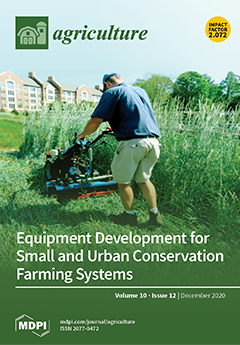The allelopathic plant extracts can be applied as soil or foliar bioherbicides and are capable of suppressing germination and growth of several weeds, some of which are herbicide resistant. This study evaluated the allelopathic activity of the aqueous extract of aerial biomass of
[...] Read more.
The allelopathic plant extracts can be applied as soil or foliar bioherbicides and are capable of suppressing germination and growth of several weeds, some of which are herbicide resistant. This study evaluated the allelopathic activity of the aqueous extract of aerial biomass of mugwort (
Artemisia vulgaris L.) on seed germination and seedling growth of redroot pigweed (
Amaranthus retroflexus L.) and maize (
Zea mays L.), in order to be applied as a potential bioherbicide. The aqueous extract of mugwort was qualitatively examined for the presence of bioactive compounds and it was applied in a Petri dish and pot bioassays quantifying its effects on redroot pigweed and maize by non-linear regression analyses according the log-logistic model. The aqueous extract of mugwort showed the presence of several bioactive compounds with allelopathic activity, such as polysaccharides, organic acids, flavonoids and terpenoids. The aqueous extract of mugwort, at the concentrations from 7.5% to 10%
w/
v, were found to be the optimal concentration range since it is able to inhibit seed germination, seedling emergence and plant growth of redroot pigweed, without affecting seed germination and seedling emergence of maize, or rather, stimulating its radicle, mesocotyl and plant’s growth. EC
90 values for the seed germination, radicle and hypocotyl length of redroot pigweed were in the order: 6.1% and 8.1%, 3.2% and 6.2%, 3.8% and 5.7%
w/
v of aqueous extract in the two repeated bioassays, respectively. Due to potential herbicidal activity against weeds and biostimulant action on the crops, this extract could be the ideal solution in an integrated weed management program, in order to suppress weeds, increasing competitive ability of crops.
Full article





